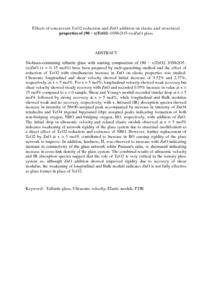Citation
Mohamed, N. B. and Yahya, Ahmad Kamal and Mohd Deni, Mohd Salleh and Mohamed, S. N. and Mohamed Kamari, Halimah and Abd. Aziz, Sidek
(2010)
Effects of concurrent TeO2 reduction and ZnO addition on elastic and structural properties of (90 − x)TeO2–10Nb2O5–(x)ZnO glass.
Journal of Non-Crystalline Solids, 356 (33-34).
pp. 1626-1630.
ISSN 0022-3093; ESSN: 1873-4812
Abstract
Niobium-containing tellurite glass with starting composition of (90 − x)TeO2–10Nb2O5–(x)ZnO (x = 0–15 mol%) have been prepared by melt-quenching method and the effect of reduction of TeO2 with simultaneous increase in ZnO on elastic properties was studied. Ultrasonic longitudinal and shear velocity showed initial decrease of 3.52% and 2.37%, respectively, at x = 5 mol%. For x > 5 mol%, longitudinal velocity showed weak recovery but shear velocity showed steady recovery with ZnO and recorded 0.95% increase in value at x = 15 mol% compared to x = 0 sample. Shear and Young's moduli recorded similar drop at x = 5 mol% followed by strong recovery at x > 5 mol%, while longitudinal and Bulk modulus showed weak and no recovery, respectively, with x. Infrared (IR) absorption spectra showed increase in intensity of NbO6-assigned peak accompanied by increase in intensity of ZnO4 tetrahedra and TeO4 trigonal bipyramid (tbp) assigned peaks indicating formation of both non-bridging oxygen, NBO and bridging oxygen, BO, respectively, with addition of ZnO. The initial drop in ultrasonic velocity and related elastic moduli observed at x = 5 mol% indicates weakening of network rigidity of the glass system due to structural modification as a direct effect of TeO2 reduction and existence of NBO. However, further replacement of TeO2 by ZnO at x > 5 mol% contributed to increase in BO causing rigidity of the glass network to improve. In addition, hardness, H, was observed to increase with ZnO indicating increase in connectivity of the glass network while Poisson's ratio, σ, decreased indicating increase in cross-link density of the glass system. The combined results of ultrasonic velocity and IR absorption spectra suggest that the role of TeO2 is very critical in the ternary glass system as, although ZnO addition showed improved rigidity due to recovery of shear modulus, the weakening of longitudinal and Bulk moduli indicates ZnO is not fully effective as glass former in place of TeO2.
Download File
![[img]](http://psasir.upm.edu.my/14353/1.hassmallThumbnailVersion/Effects%20of%20concurrent%20TeO2%20reduction%20and%20ZnO%20addition%20on%20elastic%20and%20structural%20properties%20of.pdf)  Preview |
|
PDF (Abstract)
Effects of concurrent TeO2 reduction and ZnO addition on elastic and structural properties of.pdf
Download (274kB)
| Preview
|
|
Additional Metadata
Actions (login required)
 |
View Item |

